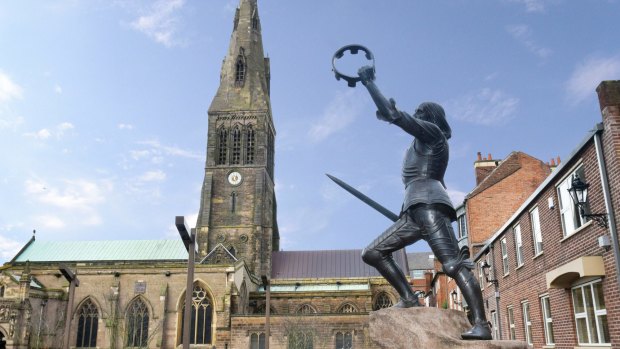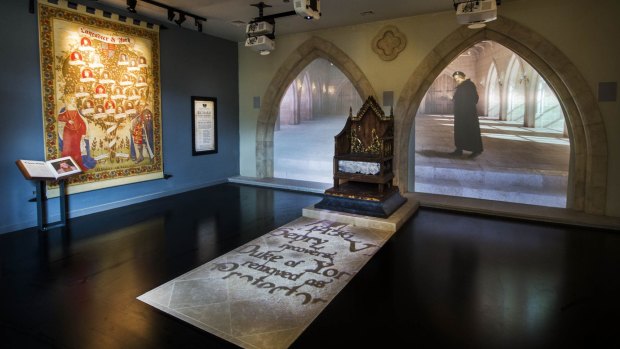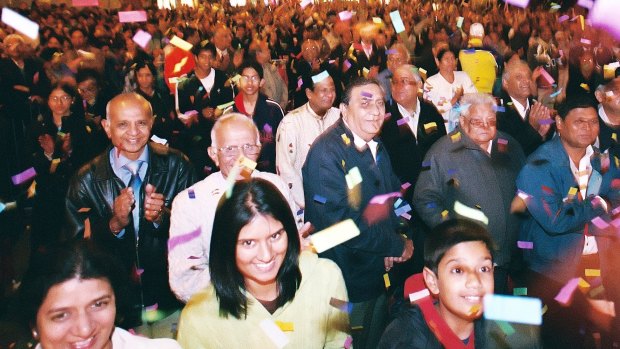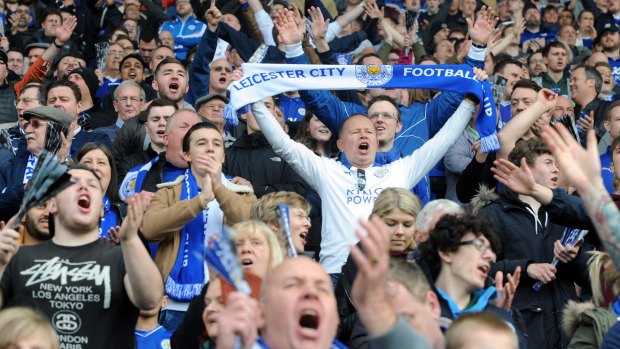This was published 8 years ago
Leicester City, UK: England's city of kings and football

The king is dead: A statue of King Richard III outside Leicester Cathedral.
Like many people in Leicester, Rebecca Hale fondly remembers March 26, 2015, the day royals, dignitaries and the world's media descended on this unassuming East Midlands city. Richard III, the last English king to die in battle, was reinterred at Leicester Cathedral, more than 500 years after he perished at Bosworth Field, and three years after his remains were found beneath a city council car park. "There was much pomp and ceremony, and we were proud that Leicester hosted such a momentous event," says Rebecca, the cathedral's volunteer manager, as she ushers me through this towering medieval building to its main attraction: the monarch's eye-catching fossil stone tomb.
"There was so much positive energy around the city, and the team seemed to tap into that. We thought they were dead and buried, and almost accepted they'd be relegated. But they just started winning. Things snowballed. And it hasn't stopped."
She's referring to Leicester City Football Club, whose revival these past 12 months has been (almost) as miraculous as the king's rediscovery.

Throne room.
"We were rock-bottom of the (English Premier) League, seven points clear of safety, when Richard was buried," recalls Rebecca, a Leicester season-ticket holder for 25 years. Not only did the Foxes survive the dreaded drop, they're now odds-on to be crowned this season's champions (having been 5000-1 outsiders for the title). Superstitious supporters reckon this Cinderella story is written in the stars – or at least in its stadium, which, since 2011, has been called the King Power, after its owners, a Thai duty-free company.
Leicester's fortunes have captivated the whole city (and country, for that matter), and in March, a 0.3 magnitude earthquake was recorded here, attributed to fans, in homes and pubs, celebrating the Foxes' last-minute winner at Norwich.
"This season has been incredible, difficult to believe," says Stephen Bruce, a Foxes follower since 1963, and a Blue Badge guide, who leads me on a Richard III-themed walking tour. These tours, he says, have been running for 40 years.

Diwali festival.
"The only thing that's really changed is the story's ending". We take in spots that the monarch visited prior to Bosworth Field – 20 kilometres west of the city, where, every August, a re-enactment commemorates the decisive tussle in the Wars of the Roses (in which Richard, of the House of York, lost to the future King Henry VII, of the House of Lancaster). We pause by Bow Bridge, which spans Leicester's river, the Soar. It's said Richard's spur hit the bridge on his way to battle. A soothsayer predicted that on his way back his head would knock the exact same spot. Apparently, it did (his corpse had been thrown over a horse and transported back to Leicester). The flurry of facts, myths and legends surrounding the deposed king are explored in Richard III: Dynasty, Death and Discovery, an absorbing new visitor centre situated opposite the cathedral and next to the hallowed car park (which, in medieval times, was the site of Greyfriars church). You can tread a glassway over the dig site and peruse various exhibits, from audio-visuals charting Richard's ascent to the throne, a 3D scan of his fatal head wounds, pieces about the remarkable excavation and DNA testing of his body, plus photographs of the thesps to have played him on stage (including Laurence Olivier and Kevin Spacey).
The centre wishes to remain impartial, says its learning and interpretation manager Rachel Ayrton, so whether Richard was a "villain", as Shakespeare portrayed him, or unfairly maligned, is for visitors to decide. One interactive slide-screen outlines the evidence behind one of English history's greatest mysteries: was Richard responsible for the death and disappearance of his nephews, the "Princes in The Tower"? While the king and the Foxes have put Leicester back on the map, there's plenty else for visitors to enjoy in the city's palpably upbeat streets: the boutiques and cafes of the quaint Leicester Lanes district, the colourful, aromatic stalls of Leicester Market (Europe's largest outdoor covered market) and the Roman ruins and mosaics of Jewry Wall. Seek out New Walk, a lovely, leafy pedestrian stretch lined with parks, handsome Georgian properties and an eclectic museum that houses everything from dinosaur fossils to funky contemporary paintings. You mustn't leave Leicester without sampling some Indian cuisine.
Almost a third of its 300,000 population has south Asian heritage, and you'll find the best eateries, and (each autumn) the liveliest Diwali celebrations, on Belgrave Road, the so-called "Golden Mile". We feast on the likes of chilli paneer, bhindi masala and crispy bhajias at Bobby's, Leicester's first Gujarati-style vegetarian restaurant. Opened in 1976, it's still in the same family, and Mr Bhagwanjibhai, its 88-year-old founder, patrols the kitchen as we dine with his grandson, Arjun, an Oxford medical student, who's back home for holidays. "Friends at university didn't really know about Leicester before," says Arjun. "I had to explain it was near Nottingham. Now, everyone knows Leicester." He's smiling. You see that a lot in Leicester these days.

Leicester fans celebrate during the English Premier League soccer match between Leicester City and Southampton at the King Power Stadium in Leicester on April 3, 2016.Credit: Rui Vieira/AP
TRIP NOTES
MORE INFORMATION
GETTING THERE
Trains to Leicester leave London St Pancras every 15 minutes (journey time: just over an hour); www.eastmidlandstrains.co.uk.
STAYING THERE
In Leicester city centre, Ramada Encore hotel has rooms priced from about $112; www.ramada.co.uk)
Steve McKenna was a guest of Visit Britain and Leicester Shire Promotions.
Sign up for the Traveller Deals newsletter
Get exclusive travel deals delivered straight to your inbox. Sign up now.